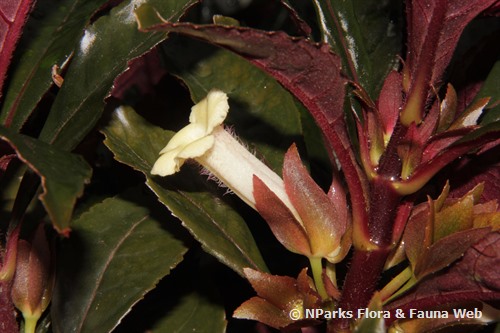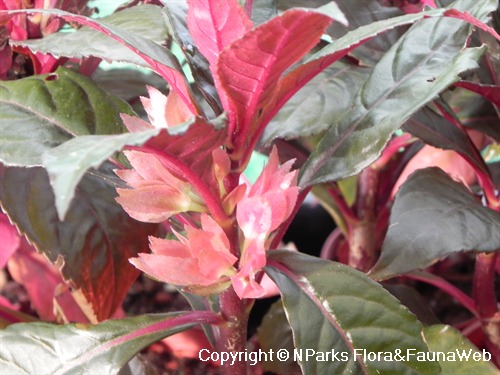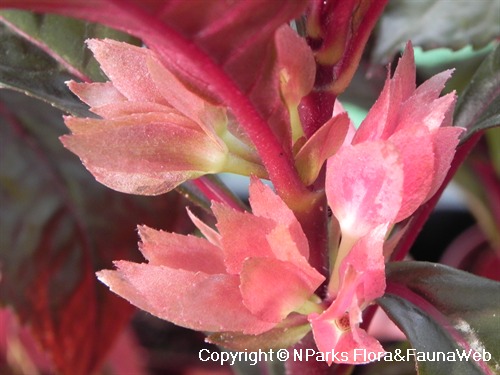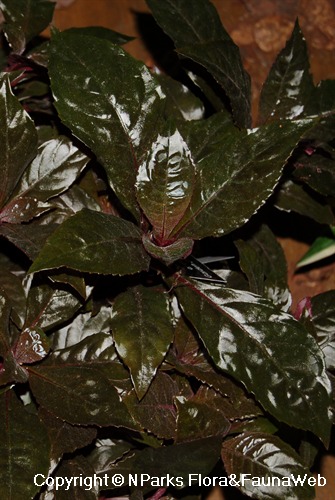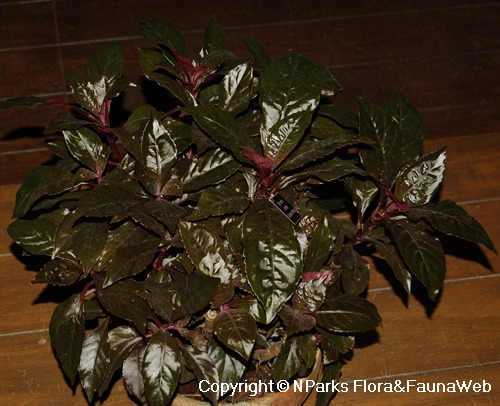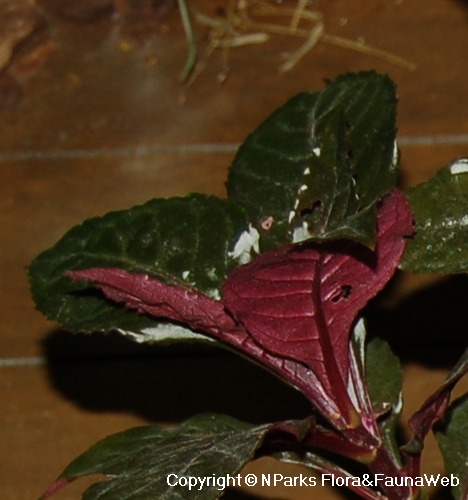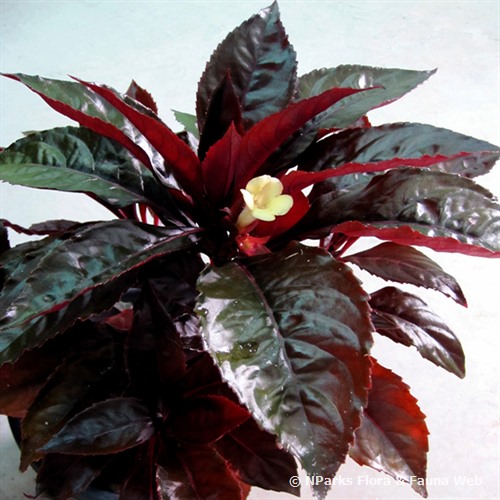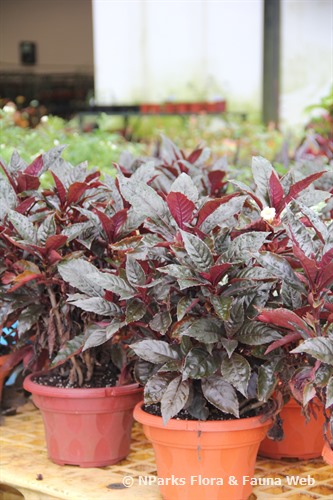
Back
Nautilocalyx lynchii (J. D. Hook) T. Sprague
| Family Name: | Gesneriaceae |
| Common Name: | Nautilus Plant, Black Alloplectus |
Name
Classifications and Characteristics
| Plant Division | Angiosperms (Flowering Seed Plants) (Dicotyledon) |
|---|---|
| Plant Growth Form | Shrub |
| Lifespan (in Singapore) | Perennial |
| Mode of Nutrition | Autotrophic |
| Maximum Height | 0.6 m |
| Maximum Plant Spread / Crown Width | 0.3 m |
Biogeography
| Native Distribution | Colombia |
|---|---|
| Preferred Climate Zone | Tropical |
Description and Ethnobotany
| Others - Plant Morphology | Growth Form: Evergreen perennial with erect, herbaceous stem. Foliage: Leaves are glossy, dark green on top and maroon below. Elliptic leaves have a serrate leaf margin. Flowers: Cream-coloured to light yellow flowers have tiny maroon spots and purple hairs. They are tubular and 5-lobed. Flowers occur in small clusters in the leaf axils (area between the leaf and stem). Fruits: Fruits are capsules. Landscaping: This species is grown mainly for its attractive, glossy leaves. The bright maroon leaf underside stands in strong contrast to the dark green colour on top. It is ideal for interior decoration and container planting. For mixed plantings in containers, pIace this species near the edge of the container. In tropical climates, it can be used in mass plantings. Cultivation: This species is easy-to-grow. Plant in deep, porous soil with good drainage. Apply a fertilzer for flowering plants every 20 - 25 days. Alternatively, add a slow release fertilizer to the soil every 3 - 4 months. This species grows best in a humid environment. It is susceptible to fungal diseases. Propagation: Propagate by seed, stem cuttings and leaf cuttings. Etymology: The genus "Nautilocalyx" comes from the Greek words for sailor ("nautilos") and calyx or leaf-like structures at the base of many flowers ("kalyx"). The reference may be to the numerous triangle-shaped sepals (collectively forming the calyx) which occur in species of this genus. The sepals may resemble sailboats. The species epithet "lynchii" was named after English botanist Richard Irwan Lynch (1850-1924), curator of Cambridge Botanic Garden. |
|---|
Landscaping Features
| Desirable Plant Features | Ornamental Foliage |
|---|---|
| Landscape Uses | Interiorscape/ Indoor Plant, Container Planting |
Fauna, Pollination and Dispersal
| Seed or Spore Dispersal | Abiotic |
|---|
Plant Care and Propagation
| Light Preference | Semi-Shade |
|---|---|
| Water Preference | Moderate Water |
| Plant Growth Rate | Moderate |
| Rootzone Tolerance | Easy to Grow, Fertile Loamy Soils, Well-Drained Soils |
| Maintenance Requirements | Moderate |
| Propagation Method | Seed, Stem Cutting, Leaf Cutting |
Foliar
| Mature Foliage Colour(s) | Green, Purple |
|---|---|
| Mature Foliage Texture(s) | Glossy / Shiny |
| Foliar Type | Simple / Unifoliate |
| Foliar Arrangement Along Stem | Opposite |
| Foliar Shape(s) | Non-Palm Foliage (Oval, Elliptical) |
| Foliar Venation | Pinnate / Net |
| Foliar Margin | Entire |
| Foliar Apex - Tip | Caudate |
| Foliar Base | Acute |
| Typical Foliar Area | Notophyll ( 20.25cm2 - 45 cm2 ) |
Non - Foliar and Storage
| Stem Type & Modification | Herbaceous |
|---|---|
| Root Type | Underground (Tap Root) |
Floral (Angiosperm)
| Flower Colour(s) | Cream / Off-White, Yellow / Golden |
|---|---|
| Flower Symmetry | Radial |
| Individual Flower Shape | Trumpet-shaped |
| Flowering Habit | Polycarpic |
Fruit, Seed and Spore
| Fruit Classification | Simple Fruit |
|---|---|
| Fruit Type | Dehiscent Dry Fruit , Capsule |
Image Repository
Others
| Master ID | 30158 |
|---|---|
| Species ID | 4467 |
| Flora Disclaimer | The information in this website has been compiled from reliable sources, such as reference works on medicinal plants. It is not a substitute for medical advice or treatment and NParks does not purport to provide any medical advice. Readers should always consult his/her physician before using or consuming a plant for medicinal purposes. |

